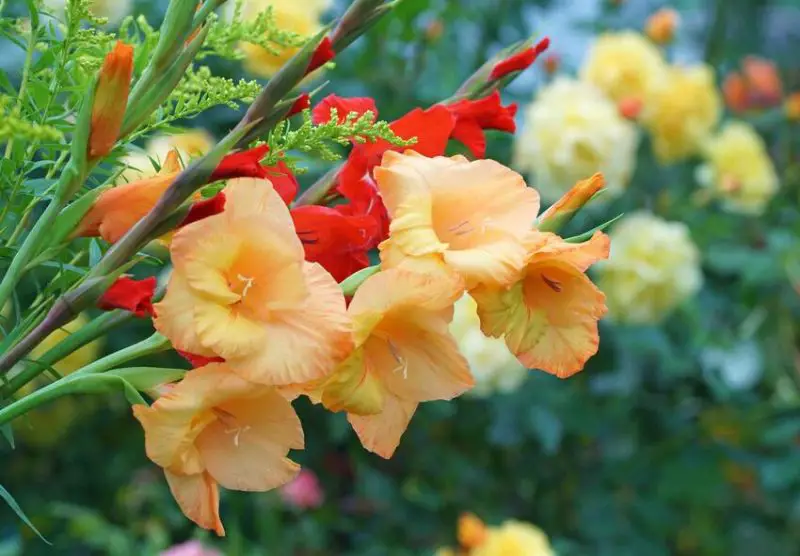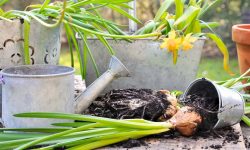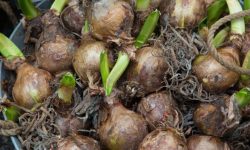Gladiolus are stunning summer-blooming flowers known for their vibrant spikes and dramatic presence. Timing their blooms correctly ensures a long-lasting, colorful display. Many gardeners wonder when do gladiolus bloom and how to maximize their garden impact. Understanding bloom cycles, planting techniques, and care routines helps achieve a spectacular floral arrangement.
Proper planning and attention to soil, light, and water allow gladiolus to reach peak bloom potential. Combining different varieties can extend flowering throughout the season. This article provides expert tips on bloom timing, growth optimization, and common mistakes to avoid.
Understanding Gladiolus Bloom Cycles

Early, Mid, and Late Bloom Varieties
Gladiolus varieties bloom at different times. Early bloomers flower in late spring, mid-season varieties in summer, and late bloomers extend into early autumn. Choosing a mix of these varieties ensures continuous color in the garden.
Bloom timing also depends on climate and planting schedules. Warmer climates can trigger earlier flowering, while cooler regions may delay blooms. By observing local patterns, gardeners can plan planting to achieve peak flowering.
Mixing early, mid, and late bloomers creates a dynamic, layered display. It also provides visual interest throughout the growing season. Careful selection ensures successive blooms, keeping gardens colorful for weeks.
Factors Influencing Bloom Timing
Several key factors determine when gladiolus bloom. Sunlight, temperature, and soil conditions play crucial roles in flower development. Adequate sunlight encourages strong bud formation and healthy, vibrant blooms. Plants receiving insufficient light may produce smaller, delayed flowers.
Soil quality affects nutrient availability and root growth. Well-drained, fertile soil rich in organic matter supports robust roots and timely flowering. Heavy clay or waterlogged soil can stunt growth and prevent buds from forming on schedule. Amending soil with compost or peat moss helps maintain proper texture and acidity.
Environmental stress also influences bloom timing. Drought, extreme heat, or late frost can damage developing buds and delay flowering. Consistent watering, mulching, and protective measures against temperature extremes minimize stress. Observing your garden regularly allows you to adjust care practices and maintain optimal growing conditions. Proper attention to these factors ensures gladiolus bloom on time and display their full color potential throughout the season.
Planting Tips for Gladiolus
Proper planting ensures gladiolus bulbs develop strong roots and bloom at the right time. Timing, soil preparation, and spacing are critical for vibrant flowers. Choosing healthy bulbs and planting at the correct depth promotes uniform growth and optimal flowering.
Planting gladiolus in well-drained soil with rich organic content prevents bulb rot. Adding compost or peat moss improves soil texture and nutrient availability. Proper soil pH, ideally between 6.0 and 6.5, ensures healthy nutrient uptake and vibrant blooms.
Spacing is also crucial. Plant bulbs 6–8 inches apart to allow air circulation and avoid overcrowding. Adequate spacing reduces competition for nutrients and water while preventing fungal disease. Consistent care and attention to planting practices set the foundation for successful growth and peak bloom.
Choosing Healthy Bulbs
Selecting healthy gladiolus bulbs is essential for strong growth and vibrant blooms. Choose firm bulbs free from mold, cuts, or soft spots. Soft or shriveled bulbs often fail to sprout or produce weak spikes. Inspect each bulb carefully before planting to ensure high-quality selection.
Larger bulbs generally yield taller spikes with more flowers. Smaller bulbs may still bloom but often need staking to remain upright. Store bulbs in a cool, dry location before planting to prevent premature sprouting or rot. Proper storage maintains bulb viability until the right planting time.
Healthy bulbs establish strong roots and vigorous shoots, laying the foundation for a colorful display. Choosing the right bulbs directly influences overall plant success and ensures consistent, long-lasting flowering throughout the season. Careful selection minimizes early failures and maximizes the visual impact of your gladiolus garden.
Soil Preparation and Planting Depth
Preparing soil correctly is crucial for gladiolus success. Loosen the soil to at least 12 inches deep to promote root growth. Incorporate organic matter such as compost or peat moss to improve drainage and fertility, providing essential nutrients for developing bulbs.
Plant bulbs at a depth approximately twice their height. Cover them with soil and water thoroughly to settle the soil around the bulbs. Correct depth protects bulbs from temperature fluctuations and supports strong, straight spikes during growth.
Monitoring soil moisture after planting ensures proper root establishment. Well-prepared soil enhances nutrient absorption and helps gladiolus emerge on time, producing healthy spikes and vibrant blooms that last throughout the season.
Sunlight and Spacing Considerations
Gladiolus require full sun, ideally at least six hours of direct sunlight per day. Adequate sunlight encourages strong stems and timely flowering. Insufficient light can delay blooms and result in weaker plants.
Spacing bulbs 6–8 inches apart prevents overcrowding and ensures proper air circulation. Good airflow reduces fungal disease risks and minimizes competition for nutrients and water.
Observing sunlight patterns in your garden helps select optimal planting locations. Combining correct light exposure with proper spacing ensures gladiolus grow tall, healthy, and produce vibrant blooms that enhance any garden display.
Watering and Fertilizing Gladiolus
Watering Techniques
Gladiolus need consistent and deep watering for optimal growth. Shallow, frequent watering encourages weak roots and poor spike development. Watering at the base ensures the root system receives adequate moisture without wetting foliage, reducing fungal risks.
Mulching helps retain soil moisture and stabilize temperature. Organic mulches like straw or bark decompose slowly, improving soil structure and preventing rapid drying. They also minimize weed competition, allowing gladiolus to access nutrients efficiently.
Monitoring soil moisture is critical, especially during hot, dry periods. Check soil depth regularly to determine when to water. Applying water too early or too late can stress plants and affect bloom timing. Consistent, deep irrigation supports spike elongation and vibrant flowering throughout the season.
Fertilizer Selection
Selecting the right fertilizer ensures gladiolus receive essential nutrients. Slow-release fertilizers or those formulated for flowering bulbs provide balanced nutrition. Avoid high nitrogen products as they promote leafy growth at the expense of flowers.
Fertilizer should be applied at planting and periodically during active growth. Nutrients support root establishment, stem strength, and spike formation. Proper feeding directly affects bloom quantity and quality.
Regular soil testing helps determine nutrient deficiencies and guide fertilizer selection. Maintaining balanced nutrition encourages healthy, vibrant spikes. Correct fertilization ensures gladiolus thrive and consistently produce strong, colorful blooms for an extended season.
Timing and Frequency
Timing fertilizer applications is critical for gladiolus success. Feed every 4–6 weeks during the growing season. Early-season feeding supports bud formation, while mid-season feeding enhances spike growth.
Avoid late-season fertilization that encourages tender growth vulnerable to frost. Monitor plant response to adjust frequency as needed. Observing soil and environmental conditions ensures feeding is effective.
Consistent care with proper timing, correct fertilizer type, and adequate watering maximizes bloom potential. Well-nourished gladiolus produce vibrant spikes, long-lasting flowers, and a strong, resilient root system throughout the season.
Pest and Disease Management
Gladiolus are susceptible to pests like thrips, aphids, and spider mites. Early detection is essential to prevent significant damage. Regularly inspect leaves and flower spikes for signs of infestation, such as discoloration, curling, or visible insects. Prompt action helps maintain healthy growth and vibrant blooms.
Use natural or chemical treatments depending on severity. Insecticidal soaps or neem oil are effective for light infestations, while stronger systemic insecticides may be required for severe cases. Rotate treatments to prevent resistance and always follow label instructions to protect plants and the environment.
Fungal diseases like botrytis or fusarium can affect gladiolus. Proper spacing, good air circulation, and avoiding overhead watering reduce risk. Remove and destroy affected plant material to prevent spread. Consistent monitoring, sanitation, and appropriate treatments ensure gladiolus remain healthy and produce beautiful flowers.
Maximizing Color and Flowering Potential
Choosing Vibrant Cultivars
Selecting the right gladiolus cultivars can dramatically influence garden aesthetics. Prioritize varieties with bright, long-lasting flowers and strong stems. Hybrids often provide superior bloom size and color intensity compared to traditional types. Healthy, disease-free bulbs are more likely to produce robust spikes with vivid colors.
When planning your garden, consider bloom timing. Combining early, mid, and late-flowering cultivars ensures a continuous display of color throughout the season. Monitor local climate patterns to choose varieties that thrive in your region. Matching cultivars to your soil type and sun exposure further enhances their performance.
Additionally, incorporating diverse colors and textures creates visual interest. Group similar shades together for a bold statement, or mix complementary colors for a more dynamic effect. Careful selection and planning of cultivars maximize the beauty and impact of your gladiolus display.
Staking and Support
Providing proper support is crucial for tall gladiolus spikes. Stakes inserted at planting or early growth stages prevent bending and breaking, ensuring that the plant maintains an upright posture. Use soft ties or clips to avoid damaging the stems while allowing natural growth.
Regularly inspect the stakes and adjust ties as the spikes grow. Ensure that airflow is not restricted, which helps prevent fungal diseases and encourages healthy development. Maintaining upright stems also enhances garden presentation and keeps blooms accessible for cutting.
For heavier varieties, multiple stakes may be required to support clusters of spikes. This structured support promotes optimal growth, showcases flowers effectively, and ensures long-lasting color throughout the flowering season.
Deadheading and Maintenance
Deadheading spent gladiolus flowers encourages the plant to redirect energy into new spikes and root development. Prompt removal of faded blooms prevents seed formation, which can drain nutrients and reduce subsequent flowering potential.
Routine inspection for pests, disease, or damaged foliage helps maintain overall plant health. Removing affected parts prevents spread and ensures vibrant, healthy flowers. Regular monitoring also allows early intervention for any emerging issues.
Additional maintenance includes gentle watering, fertilization, and mulching around the base. These practices support consistent bloom quality and extend the flowering period. Well-maintained gladiolus plants exhibit stronger colors, sturdier stems, and a longer-lasting visual impact throughout the season.
Extending Bloom Season and Successive Planting
Staggered Planting
To extend the bloom period, plant gladiolus corms every two to three weeks. This creates successive waves of flowering and avoids a single, short-lived peak. Early planning ensures planting aligns with local climate and soil conditions, optimizing growth.
Staggered planting also allows gardeners to manage water, fertilization, and staking efficiently. Smaller, consistent maintenance efforts prevent burnout and support healthier plants. By spacing corms over time, flower display is continuous, keeping the garden vibrant.
Timing intervals are flexible depending on regional weather. In warmer climates, shorter gaps may be feasible, while cooler areas require longer intervals. Observing plant development helps adjust planting schedules for maximum visual impact.
Successive Blooming Varieties
Selecting early, mid, and late-flowering gladiolus varieties extends garden color throughout the season. Early bloomers brighten spring, mid-season varieties maintain momentum, and late bloomers provide striking summer displays. A mixture creates continuous interest in the landscape.
Disease-resistant cultivars reduce maintenance and prolong flower health. Confirm that all chosen varieties thrive in your garden’s sun and soil conditions to ensure consistent growth. Combining contrasting colors enhances visual appeal.
Planning cultivar combinations strategically maximizes bloom length and impact. Mixing different heights and flower forms adds dimension. Attention to variety selection directly affects overall garden aesthetics and enjoyment.
Care for Prolonged Flowering
Regular watering and appropriate fertilization promote sustained growth and vibrant blooms. Deadhead spent flowers promptly to encourage additional spike formation and prevent nutrient diversion to seeds. Healthy foliage supports continued development of new flowers.
Mulching maintains soil moisture and regulates temperature, improving root health. Monitoring for pests and diseases ensures plants remain vigorous and productive. Early intervention prevents loss of flowers and reduces long-term issues.
Consistency in care, along with strategic planting, maximizes bloom potential. Attentive maintenance ensures strong, colorful spikes throughout the flowering season, providing a lasting and visually impressive garden display.
Post-Bloom Care and Corm Storage
After flowering, gladiolus require careful post-bloom care. Allow foliage to yellow naturally, as this process helps transfer nutrients back to the corm for next season. Avoid cutting leaves too early, which can weaken the plant and reduce future blooms.
Dig up corms after the foliage dies back. Clean them gently and remove soil, trimming away any diseased or damaged portions. Allow corms to dry in a well-ventilated, shaded area for several days to prevent rot during storage.
Store corms in a cool, dry place, ideally between 10–15°C, in ventilated containers. Label varieties for future planting. Proper post-bloom care and storage ensure strong, healthy corms ready to produce vigorous blooms the following season.
Companion Plants for Gladiolus
Choosing companion plants enhances the visual appeal of gladiolus displays. Selecting plants with complementary heights, colors, and bloom times creates a dynamic garden. Low-growing ground covers or border flowers can frame the spikes, highlighting their vibrant colors. Mixing contrasting colors emphasizes gladiolus blooms and adds depth to garden beds.
Consider flowering perennials that share similar sunlight and soil requirements. Plants such as daylilies, salvia, and coreopsis thrive in well-drained soil with full sun, like gladiolus. Staggered bloom periods from companion plants extend seasonal color, maintaining visual interest before and after gladiolus flowers fade. Additionally, companion plants can attract pollinators and beneficial insects, improving overall garden health.
Proper spacing and arrangement prevent competition for nutrients and light. Taller companions can provide wind protection for delicate gladiolus spikes. Incorporating diverse textures and foliage enhances aesthetic appeal and creates a balanced garden environment. Thoughtful selection and placement of companion plants maximize bloom display and promote long-lasting, vibrant color in the garden.
Monitoring Bud Development
Careful observation of gladiolus bud development is essential for maximizing bloom quality. Early detection of healthy bud formation allows gardeners to adjust care routines, including watering, fertilization, and staking. Regular checks help identify issues such as pests, diseases, or nutrient deficiencies before they affect flower spikes.
Spacing plants properly ensures adequate airflow and sunlight exposure. Crowded plants may produce smaller or delayed blooms. Monitoring bud size, color, and firmness helps gauge overall plant health. Timely interventions, such as removing weak buds or damaged spikes, redirect energy to the strongest flowers, improving bloom display.
Environmental factors like temperature fluctuations, rainfall, and soil moisture directly affect bud development. Maintaining consistent conditions promotes uniform flowering. Applying supportive care, including mulch, trellises, and appropriate fertilization, ensures strong stems and vibrant blooms. Consistent observation and maintenance are key to achieving prolonged and visually striking gladiolus displays.
Maximizing Bloom Through Fertilization
Proper fertilization is crucial for gladiolus to reach full bloom potential. Balanced nutrients support strong roots, healthy foliage, and vibrant flower spikes. Using fertilizers formulated for flowering bulbs ensures that plants receive the right ratio of nitrogen, phosphorus, and potassium. Nitrogen encourages leaf growth, phosphorus strengthens root and flower development, and potassium promotes overall plant resilience.
Timing is key for effective feeding. Apply fertilizer before the growing season begins to stimulate early root development. Post-bloom fertilization helps replenish nutrient reserves and prepares corms for the next season. Avoid late-season fertilization, which may stimulate growth that cannot harden before frost, risking damage to tender shoots and buds.
Consider soil conditions and amend as needed. Testing pH and nutrient levels allows precise fertilization and reduces over-application risks. Slow-release fertilizers provide steady nutrition throughout the growth period. Regular observation ensures that gladiolus receives the right amount of nutrients without causing excessive leafy growth or reduced flowering.
In combination with proper watering, mulching, and staking, targeted fertilization maximizes flower size, color, and longevity. Attention to nutrient balance and timing helps gardeners achieve the most spectacular displays. Healthy, well-fed gladiolus not only produce more blooms but also maintain strong stems and vibrant foliage, ensuring a long-lasting, visually striking garden.
Common Gladiolus Mistakes to Avoid
Planting Too Deep or Shallow
Many gardeners plant gladiolus corms at the wrong depth, which affects growth and blooming. Too deep, and shoots struggle to emerge. Too shallow, and roots dry out or corms shift during watering or wind. Ideal depth is typically twice the height of the corm to ensure stability and root development.
Soil texture also plays a role. Loose, well-drained soil prevents waterlogging, while clay-heavy soil can retain moisture, leading to rot. Adding organic matter improves soil structure and ensures healthy roots. Regularly observing new growth helps determine if adjustments are needed.
Correct planting depth strengthens stems and supports nutrient absorption. It maximizes flower quality and ensures uniform bloom timing. Proper planting is a simple but critical step for a thriving garden.
Inconsistent Watering
Gladiolus requires consistent moisture, especially during active growth. Irregular watering stresses the plant, resulting in uneven flowering and weak stems. Overwatering promotes corm rot, while under-watering causes wilting and reduced bloom size.
Watering early in the day helps reduce fungal issues. Mulching keeps the soil moist and roots cool, creating an optimal environment. Checking soil moisture regularly ensures plants receive the right amount of hydration.
Consistent watering encourages strong flower spikes, prolonged blooms, and healthy foliage. Proper hydration is essential for nutrient uptake and overall plant vitality.
Fertilizer Mismanagement
Applying the wrong fertilizer or incorrect amounts harms gladiolus growth. Excess nitrogen encourages leafy growth over flowers, while insufficient nutrients stunt overall development and color vibrancy.
Use fertilizers designed for flowering bulbs, rich in phosphorus and potassium. Apply at pre-growth and post-bloom stages for maximum effect. Slow-release fertilizers provide steady nutrition and reduce risk of overfertilization.
Regular soil testing helps monitor nutrient levels and adjust feeding schedules. Correct fertilization ensures strong roots, vibrant spikes, and consistent flowering throughout the season.
FAQ About When Gladiolus Bloom
What is the best time of day to water gladiolus?
The optimal time to water gladiolus is early morning. Morning watering allows soil to absorb moisture before daytime heat increases evaporation. It ensures that roots stay hydrated without waterlogging. Wet foliage dries quickly in the sun, reducing the risk of fungal diseases. Consistent morning watering supports strong stems, healthy foliage, and abundant flower production throughout the season.
How can I prevent pests from damaging my gladiolus?
Gladiolus are prone to thrips, aphids, and spider mites. Regularly inspect leaves and flower spikes for signs of infestation, such as discoloration, curling, or visible insects. Remove affected leaves promptly to prevent spread. For minor infestations, use insecticidal soaps or neem oil. Severe infestations may require targeted treatments. Proper spacing, adequate sunlight, and good air circulation further reduce pest pressure, helping plants remain healthy and vibrant.
How should I store gladiolus corms after blooming?
Allow foliage to yellow naturally after flowering to transfer nutrients to the corms. Carefully dig up corms, remove soil, and discard any damaged or diseased parts. Dry corms in a shaded, ventilated area for several days to prevent rot. Store them in a cool, dry location around 10–15°C in ventilated containers. Label each variety for easy identification. Proper post-bloom care and storage maintain strong, healthy corms ready for the next planting season.
Can I extend the blooming period of gladiolus?
Yes, stagger planting corms every 2–3 weeks and mix early, mid, and late-flowering varieties. Deadhead spent blooms and provide consistent watering and fertilization. Adequate sunlight, well-drained soil, and mulching support healthy growth. Choosing disease-resistant cultivars ensures uninterrupted flowering. These steps create a prolonged, vibrant floral display throughout the growing season.
What are common mistakes that reduce gladiolus bloom?
Common mistakes include using the wrong fertilizer, poor soil preparation, overwatering, or planting in insufficient sunlight. Frost damage, neglecting bud development, and improper spacing also limit blooms. Avoid high-nitrogen fertilizers, ensure well-drained soil, and maintain proper watering. Observing local climate and caring for corms properly enhances flowering potential, ensuring abundant, healthy blooms.
Conclusion
Mastering gladiolus care ensures vibrant blooms year after year. Understanding bloom timing, proper watering, fertilization, and pest management allows gardeners to enjoy long-lasting color. Paying attention to soil preparation, staggered planting, and corm storage enhances flowering potential. Avoiding common mistakes like overwatering or insufficient sunlight keeps plants healthy and strong. Consistent, attentive care transforms your garden into a breathtaking display of gladiolus, highlighting nature’s beauty while providing endless satisfaction and enjoyment for gardeners of all skill levels.






